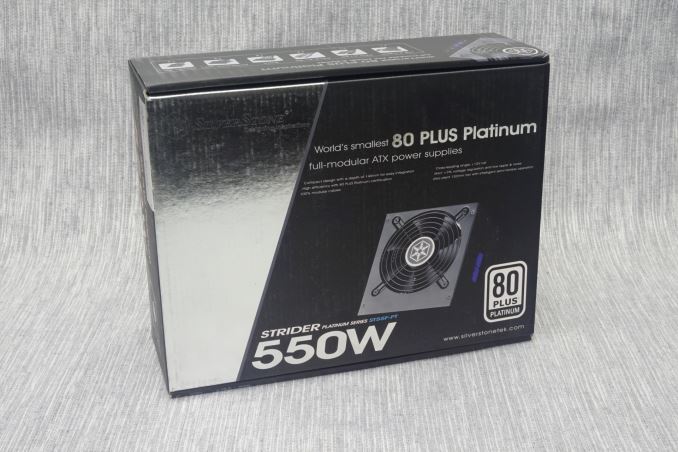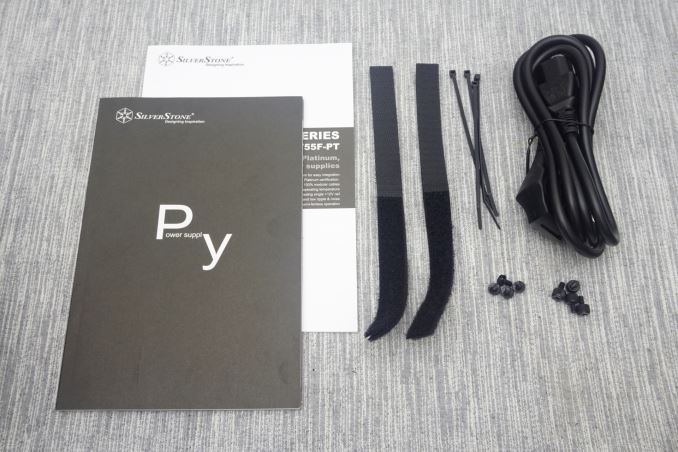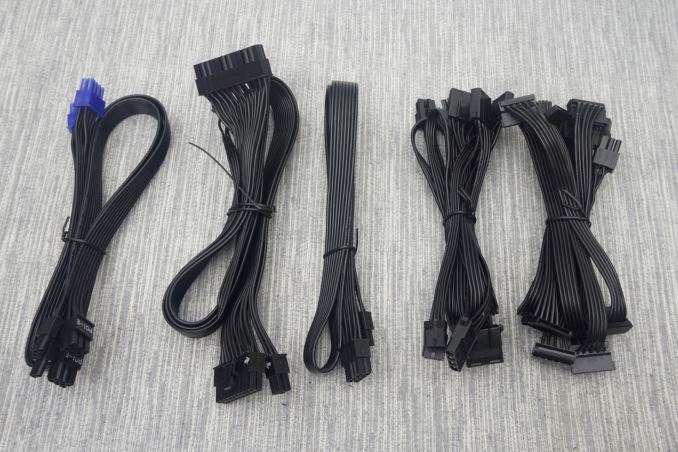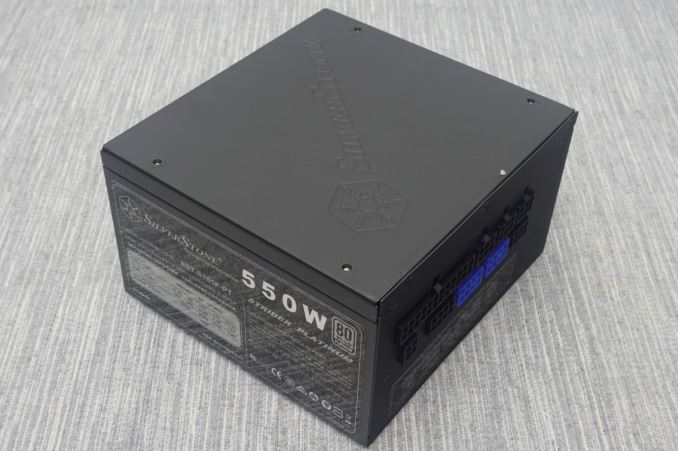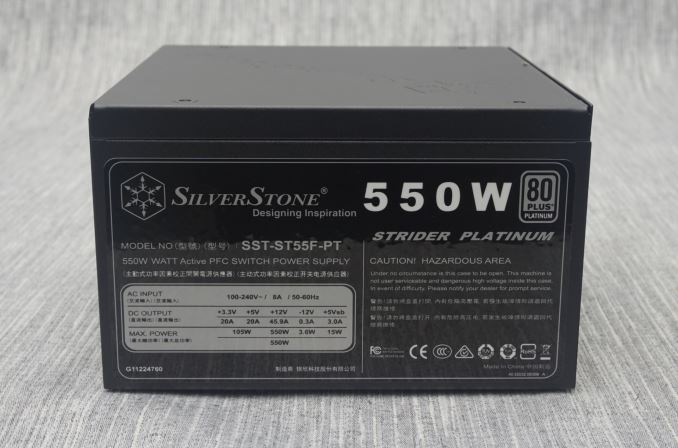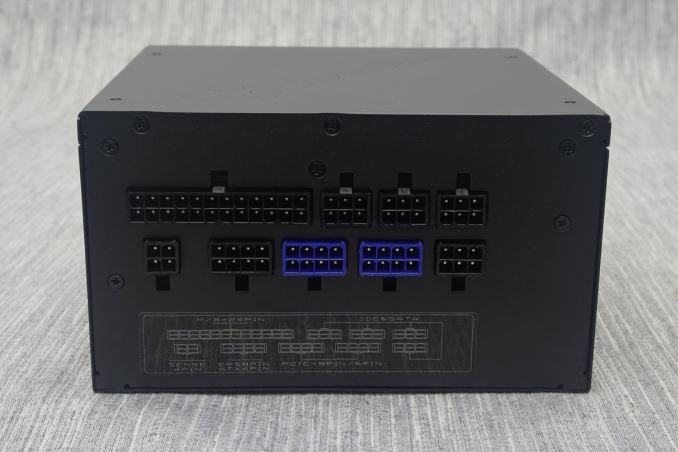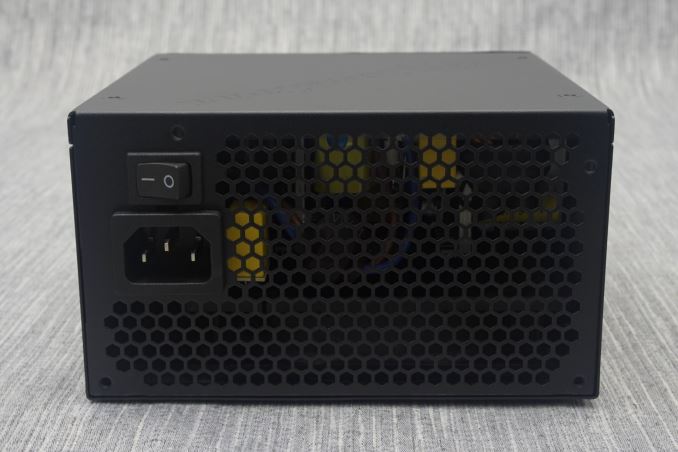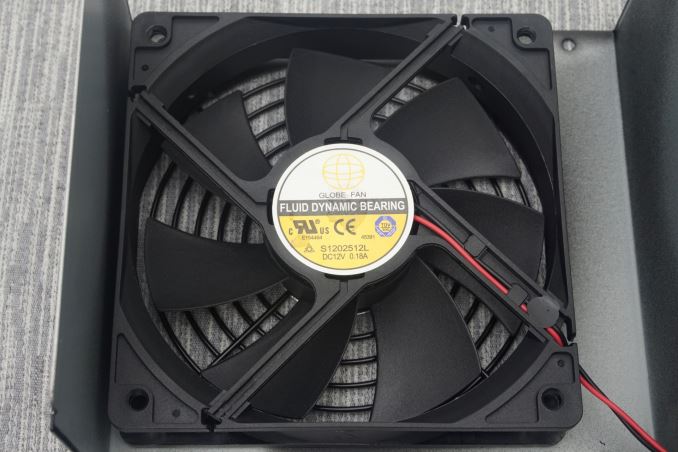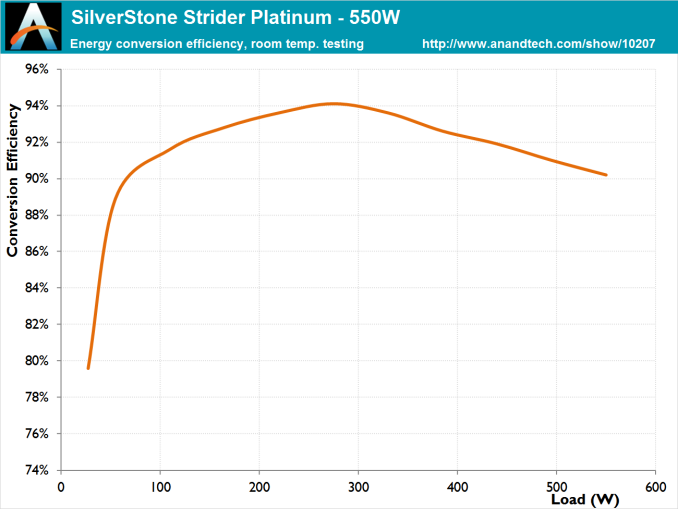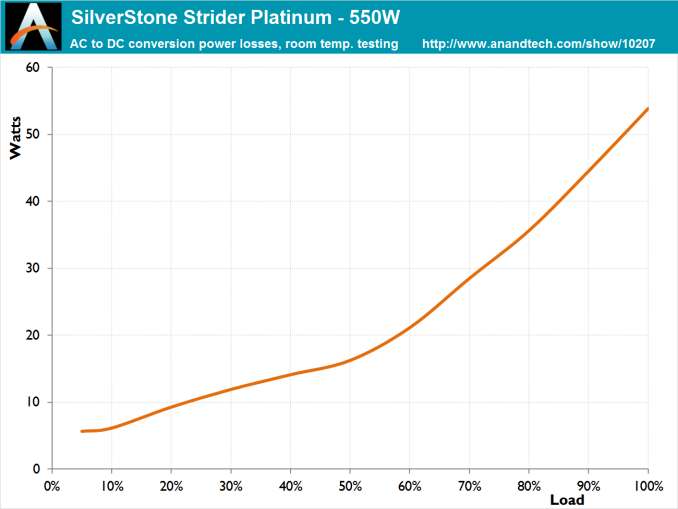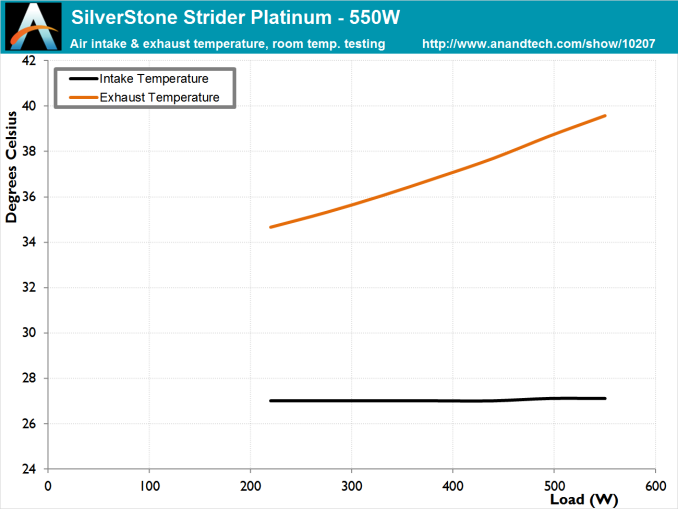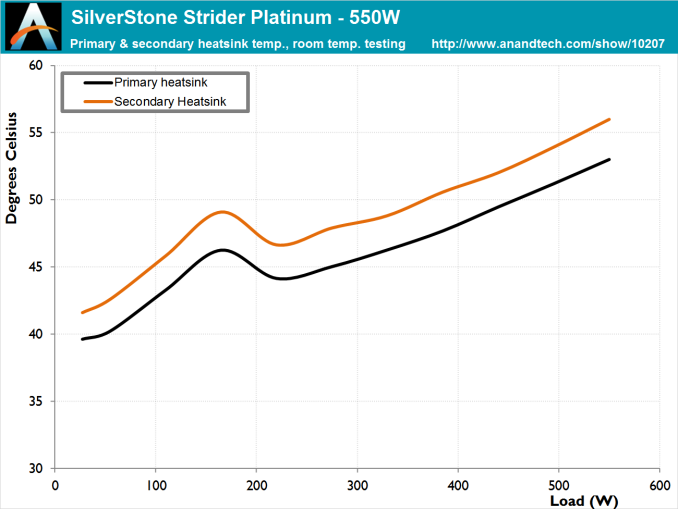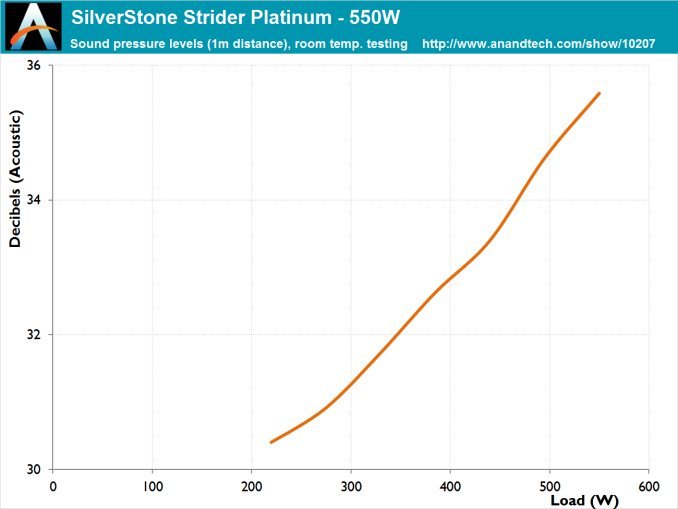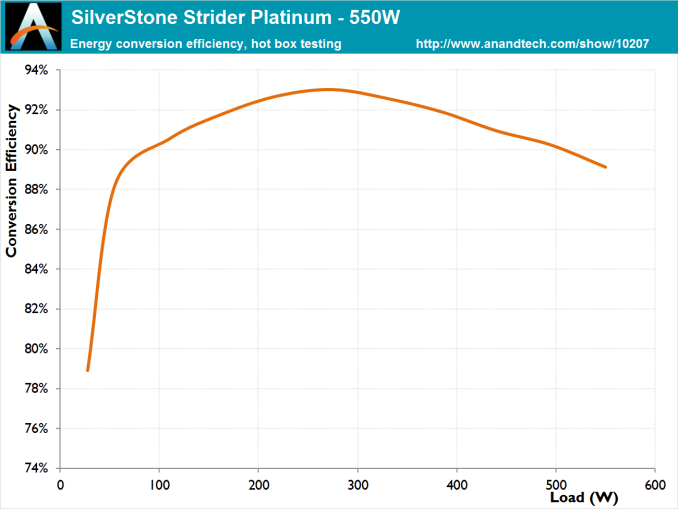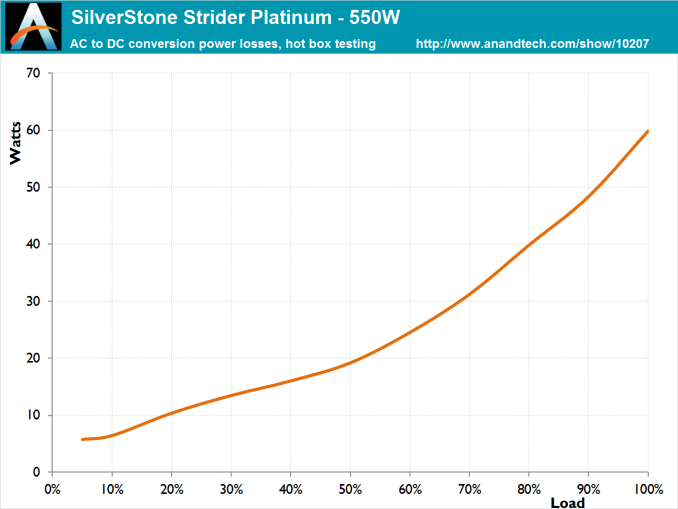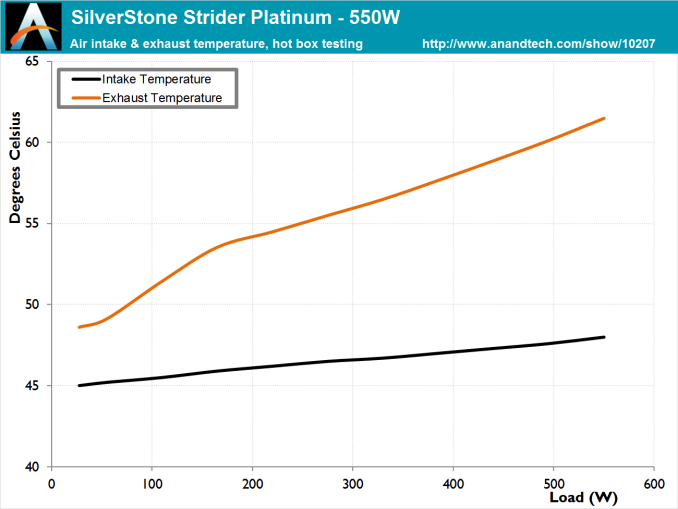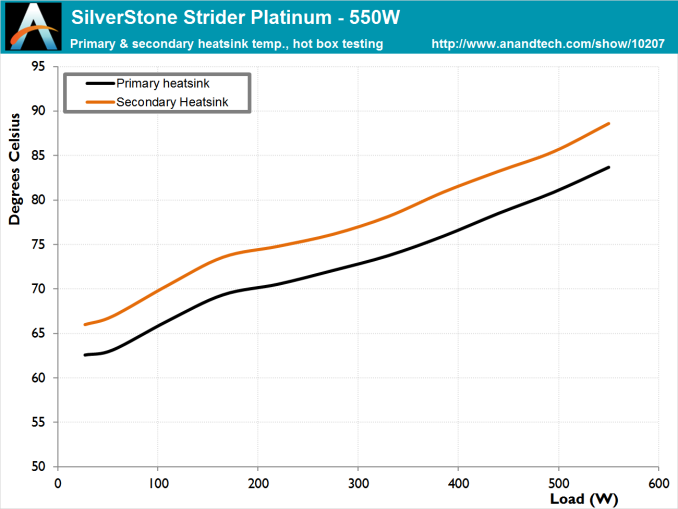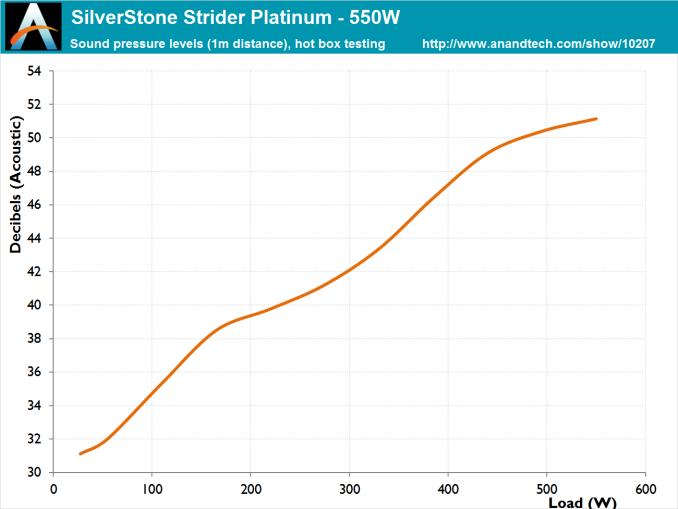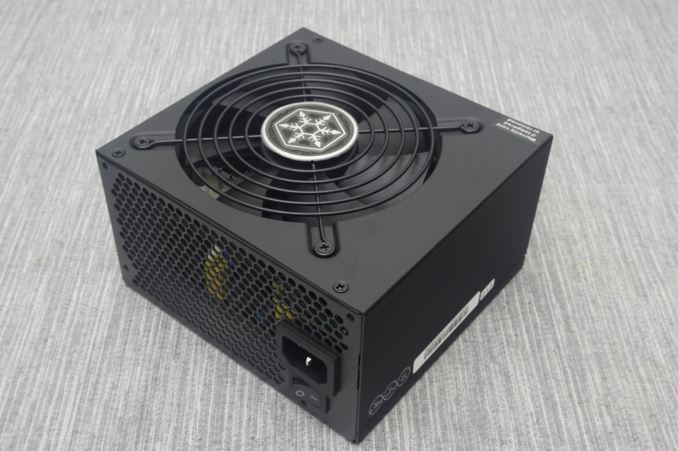
Original Link: https://www.anandtech.com/show/10207/the-silverstone-strider-platinum-550w-psu-review
The SilverStone Strider Platinum 550W PSU Review
by E. Fylladitakis on April 8, 2016 8:00 AM EST- Posted in
- PSUs
- Cases/Cooling/PSUs
- 550W
- SilverStone
- 80Plus Platinum
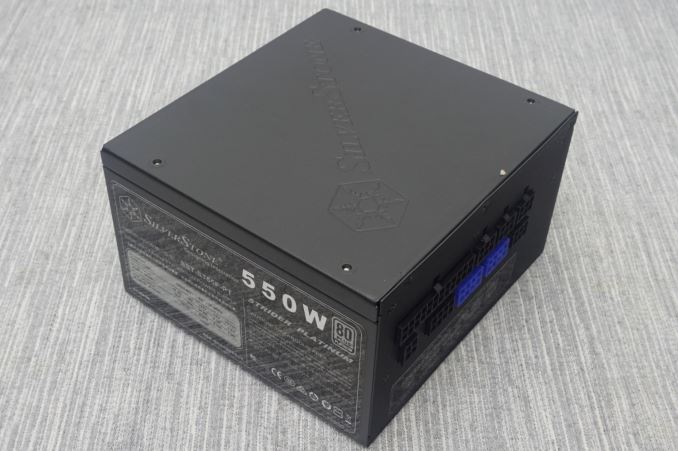
SilverStone is a well-known manufacturer of PC cases and PSUs, famed for their obsession with small form factor and proprietary systems. They are one of the very few companies for whom a large portion of their retail products consists of SFX and compact cases, alongside with several proprietary ATX designs, such as the Fortress FT05 that we reviewed a few months ago. Such designs, even though they are frequently made to support ATX PSUs, have limiting PSU compartments and can cause compatibility problems with longer, high output units.
To combat that, SilverStone is focusing most of their PSU designs to be as small as possible, frequently adhering to the ATX standard. Almost every ATX PSU they currently market with a power output under 800 Watts is just 140 mm long. Even the most powerful PSU they currently produce, the Strider Gold S 1500W unit, is only 180 mm long, significantly shorter than other designs of equivalent power output.
Along these lines, today we are having a look at SilverStone's Strider Platinum series. As the name suggests, these are the 80Plus Platinum certified designs that SilverStone currently offers. The series consists of three units sharing the same core platform, all just 140 mm long, with their power outputs ranging from 550 to 750 Watts. A quick look at their specifications reveals numerous interesting features, as well as the fact that these are units whose performance is rated at 40 °C. We put the 550 Watt version of the Strider Platinum to the test and examine its features, performance, and value.
| Power specifications ( Rated @ 40 °C ) | |||||
| AC INPUT | 100 - 240 VAC, 50 - 60 Hz | ||||
| RAIL | +3.3V | +5V | +12V | +5Vsb | -12V |
| MAX OUTPUT | 20A | 20A | 45.9A | 3A | 0.3A |
| 105W | 550W | 15W | 3.6W | ||
| TOTAL | 550W | ||||
Packaging and Bundle
The cardboard packaging of the Strider Platinum is of typical size and sturdy enough to provide protection during transport. Aesthetically, the theme is simplistic and serious, focused mainly around large silvery areas reflecting the “Platinum” topic of the PSU. The main features of the PSU are printed on the front side of the box, while more specific details can be found on its sides and rear.
SilverStone supplies a fairly rich bundle alongside with their Platinum series units. Inside the box we found a standard AC power cable, four black mounting screws and four black thumbscrews, a few cable ties, four long cable straps and a well-written manual.
The modular cables of the Strider Platinum are "flat" type, ribbon cables, including the main 24-pin ATX cable. All of the wires and connectors are black, with the sole exception being the PSU side connectors of the PCI Express cables, which are blue.
| SilverStone Strider Platinum 550W | ||
| Connector type | Hardwired | Modular |
| ATX 24 Pin | - | 1 |
| EPS 4+4 Pin | - | 1 |
| EPS 8 Pin | - | - |
| PCI-E 6+2 Pin | - | 2 |
| PCI-E 8 Pin | - | - |
| SATA | - | 8 |
| Molex | - | 6 |
| Floppy | - | 2 |
External Appearance
Strictly speaking, the external design of the Strider Platinum is unsophisticated. SilverStone went with a minimalistic design, steering away from fancy side stickers and eye-catching colors. The chassis of the PSU is sprayed with a satin black paint, which is excellently applied and highly resistant to smears and fingerprint marks. Due to its reduced length, SilverStone is forced to use a 120 mm cooling fan that is placed offset towards the left side of the unit.
SilverStone placed the sticker with the electrical specifications and certifications of the PSU on the left side of the chassis, making it visible from a windowed side panel if the PSU is installed with its fan facing downwards. The right side of the chassis is entirely plain. SilverStone engraved their company logo on the top side of the chassis, but the engraving is very subtle and most likely will not be easily visible inside a case, even if there is strong illumination.
The rear of the Strider Platinum is very simple, with only the AC cable receptacle and a small on/off switch to be found. Nine connectors for the eight modular cables can be found at the front side of the PSU. The blue connectors are for PCI Express cables and SilverStone is using them to differentiate from the similar CPU EPS connector, which is black. The connectors are keyed, meaning that you cannot really push a PCI Express cable into the EPS connector and vice versa, unless a lot of force becomes involved. Finally, sole 4-pin connector is not a power connector at all, but rather is the connector for the PSU's voltage sense feature, which allows the PSU to monitor the voltages on the 24-pin ATX cable and is supposed to improve the power quality of the PSU.
Internal Design
Globe supplies the 120 mm fan for the cooling needs of the PSU. The 120 mm fan is a high quality model with an FDB (fluid dynamic bearing) engine and, with a maximum speed of just 2000 RPM, actually is the least powerful between Globe’s similar offerings, hinting that SilverStone has great faith on the efficiency of their product.
The OEM behind the creation of the Strider Platinum is Sirfa, with the PSU based on an upgraded version of the Astro Lite HPM platform. It is not a complex design and Sirfa originally used it to achieve 80Plus Gold efficiency, but apparently SilverStone managed to squeeze even better performance out of it. The input filtering stage consists of four Y capacitors, two X capacitors, two filtering inductors and one surge-suppressing MOV, ending to a single input conversion bridge that can be seen on its own small heatsink. The passive APFC components are a 400V/390μF capacitor supplied by Nippon Chemi-Con and a shielded inductor. The primary inversion stage is a half-bridge design and the main transformer has a single 12V output.
On the secondary, the DC to DC conversion circuits used to generate the minor voltage lines can be seen on their own vertical PCB. Thick wires are being used to connect the main PCB with the connector’s PCB, creating a little bit of a mess. Nippon Chemi-Con supplies all of the electrolytic and a couple of the polymer capacitors, with the rest of the polymer capacitors coming from Teapo. One thing of note is that three temperature sensors can be seen attached on the secondary side heatsink, which is inexplicable for a PSU without exotic functions, as the designer could probably pull off all of the functions of the Strider Platinum by using just one.
Cold Test Results
For the testing of PSUs, we are using high precision electronic loads with a maximum power draw of 2700 Watts, a Rigol DS5042M 40 MHz oscilloscope, an Extech 380803 power analyzer, two high precision UNI-T UT-325 digital thermometers, an Extech HD600 SPL meter, a self-designed hotbox and various other bits and parts. For a thorough explanation of our testing methodology and more details on our equipment, please refer to our How We Test PSUs - 2014 Pipeline post.
The conversion efficiency of the Strider Platinum 550W at room temperature is good, although it technically missed the 80Plus Platinum certification limits during our testing. For 80Plus Platinum units under 230VAC input, the directive dictates that the unit should have an efficiency of at least 92% under 20% load and our instrumentation ended up recording 91.6% at that point. The actual difference is small and can be even attributed to the slightly higher ambient temperature of our testing environment (room temperature is defined as 25 °C and that is used for 80Plus certification tests, while our room temperature was nearly 27 °C at the time of our testing). The average efficiency is 92.4% within the nominal load range (20% to 100% of the unit's capacity) and reaches up to 94.1% at 50% load, just above the 80Plus Platinum certification mark. It is also worthwhile to mention that the Strider Platinum displayed some of the best low load efficiency figures that we have seen to this date.
As this is a semi-fanless (zero fan speed idle) design, the fan is programmed not to start until it is necessary for the cooling needs of the unit. During our testing in room temperature, the fan started right before the load reached 220 Watts, 40% of the unit’s maximum capacity. After that point, the fan started and continued to increase its speed alongside with the load, but barely reached up to 60% of its maximum speed at full load, generating just above 36 dB(A). Due to the relatively high efficiency of the PSU, the Strider Platinum held low operating temperatures during our room temperature testing, barely reaching above 55 °C.
Hot Test Results
Looking at a detailed breakdown of performance under higher temperatures, the SilverStone Strider Platinum delivers mediocre electrical performance under stress for a PSU of its class. Our instrumentation recorded a maximum ripple of 60 mV on the 12V line, which is half of the 120 mV design limit, yet not really good for a premium PSU. Similarly, the voltage ripple on the 3.3V and 5V lines is 20mV and 26mV respectively. The voltage regulation leaves much to be desired as well, since we recorded excellent regulation of just 1.8% for the 12V line, but higher than 3.2% for the 3.3V/5V lines. These figures are uninspiring for a premium PSU design and surpass even the advertised 3% regulation.
| Main Output | ||||||||
| Load (Watts) | 111.94 W | 278.08 W | 413.92 W | 548.1 W | ||||
| Load (Percent) | 20.35% | 50.56% | 75.26% | 99.65% | ||||
| Amperes | Volts | Amperes | Volts | Amperes | Volts | Amperes | Volts | |
| 3.3 V | 1.74 | 3.43 | 4.34 | 3.4 | 6.51 | 3.36 | 8.68 | 3.31 |
| 5 V | 1.74 | 5.16 | 4.34 | 5.09 | 6.51 | 5.07 | 8.68 | 5 |
| 12 V | 7.97 | 12.17 | 19.92 | 12.11 | 29.87 | 12.02 | 39.83 | 11.95 |
| Line | Regulation (20% to 100% load) |
Voltage Ripple (mV) | |||||
| 20% Load | 50% Load | 75% Load | 100% Load | CL1 12V |
CL2 3.3V + 5V |
||
| 3.3V | 3.5% | 10 | 16 | 18 | 20 | 12 | 22 |
| 5V | 3.2% | 12 | 18 | 20 | 26 | 14 | 26 |
| 12V | 1.8% | 26 | 30 | 46 | 60 | 68 | 36 |
Even though this PSU is rated at 40 °C, we had no problem reaching it with a significantly higher ambient temperature. The impact on the conversion efficiency was minimal, with average nominal load (20-100%) efficiency dropping by only 1%, with a balanced drop across the entire load range and only slightly greater at maximum load, indicating that the components are not being overly stressed. The maximum efficiency now is 93% at 50% load, dropping down to a minimum of 89% at maximum load.
The semi fanless design of the Strider Platinum did not like the high ambient temperature inside our hotbox at all, forcing the fan to start nearly instantly after the PSU has been powered on. In order to combat the high ambient temperatures and, consequently, the high internal temperatures of the unit, the fan’s speed increases significantly alongside with the load, reaching nearly its maximum speed at 100% capacity. With a load greater than 200 Watts under such adverse conditions, the Strider Platinum would be clearly audible by the system’s user if a room reached these conditions. Nevertheless, the internal temperatures of the PSU do not get overly high, with the heatsinks staying below 90 °C under maximum load.
Final Words
In designing the Strider Platinum series, SilverStone has put together a PSU that can deliver high overall performance and quality while maintaining compact proportions. In fact this is almost to the exclusion of everything else - the company does not seem interested in competing in terms of raw performance, aesthetics, or even value - with an end goal of enticing those builders who require a high performance product but are facing spatial restrictions that rule out some (or most) of the competitive products. For this reason, there are not many 80Plus Platinum certified and modular PSUs with that kind of output, performance and warranty with a chassis that is just 140 mm long.
Despite the relatively small chassis, the Strider Platinum 550W PSU that we have tested exhibited a good balance between thermal performance and acoustics. It remains silent when lightly loaded and operating within typical ambient temperatures, and the cooling system does react well and keeps the unit from overheating when the operating conditions are adverse. Despite the fact that this unit has been rated for operation at 40 °C ambient temperature, it had no problem delivering its maximum power output and maintaining good internal temperature readings under worse conditions.
However unlike the excellent thermal and acoustics performance, the electrical performance of the Strider Platinum is only mediocre for a product of this class. This cannot be attributed to the small size of the chassis, but it may be partially attributed to use of a modified platform that was originally designed for lower class units. That does not mean that the Strider Platinum has poor electrical performance: the power quality is very good and far from the ATX design guide limit, while the efficiency is high. Although the Strider Platinum failed to meet the 80Plus Platinum efficiency under 20% load during our testing, it also showed some of the better <10% load efficiency figures that we have seen over the years. We are simply saying that, considering the class and cost of the PSU, the electrical performance could have been significantly better.
Ultimately what makes in particular the 550W version of the Strider Platinum competitive is not only its small physical proportions, but the lack of severe competition. There are very few 80Plus Platinum certified PSUs with an output lower than 700 Watts, as most manufacturers are focused on improving the efficiency of their >700 Watt models. Some may argue that the benefits of an 80Plus Platinum certified PSU over an 80Plus PSU are indiscernible when comparing PSUs with a maximum output below 700 Watts, and they are limited to just a few Watts, but there is a difference and can have a measurable impact on the thermal performance and longevity of the PSU. This is of particular importance for the kind of applications that SilverStone intends the Strider Platinum for, which will most likely involve small, cramped spaces with limited cooling.
We found the Strider Platinum 550W retailing for $110 and other 80Plus Platinum certified 550W PSU are sharing similar price tags, with the sole exception of the Enhance-made Rosewill Quark 550W that currently retails for $20 less. As such, if a very high efficiency 550W PSU is needed, then SilverStone’s Strider Platinum sits in an interesting niche and will certainly not disappoint.

